Ymddiheuriadau, ond nid yw cyfieithiad Cymraeg y tudalen hwn ar gael eto. Dyma'r testun Saesneg:
New Quay Harbour Company
Introduction to the collection
This collection, which was catalogued in April 2015, covers the pre-formation, the formation, the operation, and the eventual transfer into local government hands, of the New Quay Harbour Company.
The material, dating from 1787 until 1953, comprises documents relating to legal matters â the Company's foundation, copies of Acts, copies of local Byelaws, and several legal disputes in which it was involved; records relating to property â title deeds, leases (including of tolls and dues), associated bills of costs, etc.; financial records, notably those concerning shareholders; correspondence; and a small number of more ephemeral items â a list of house name, and of ships, in New Quay, for example.
Whilst the material, on the whole, relates to New Quay, in the County of Cardiganshire (as was, now Ceredigion), west Wales, some material relates to other places in Cardiganshire (namely, the harbours of Aberystwyth and Aberaeron), and one document to Bristol Harbour.
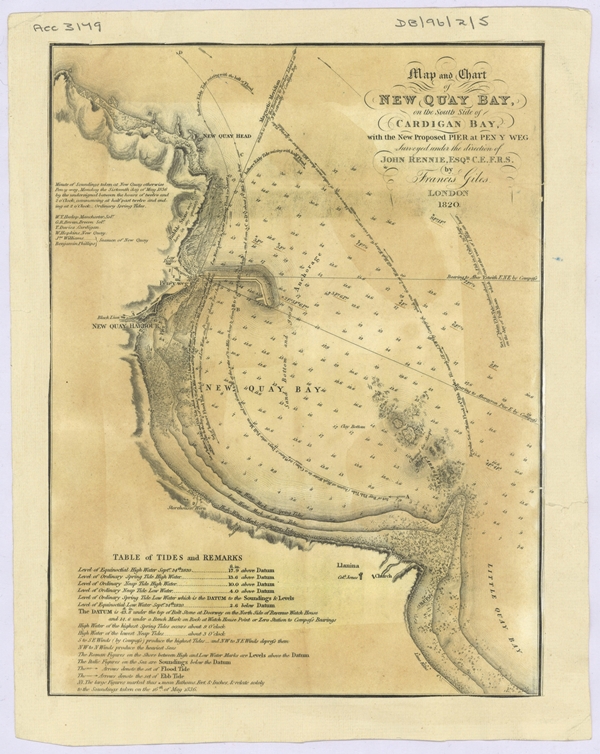
Map and Chart of New Quay Bay: DB/96/2/5
New Quay Harbour Company: history and records
Moves to build a pier at New Quay had been mooted since the late 18th century (Passmore, 1992: p.17), but it was not until the early 19th century that those discussions took on a greater possibility of becoming a concrete reality. In 1820 the Reverend Alban Thomas Jones Gwynne, who was instrumental in Aberaeron's Harbour Act of 1807, engaged John Rennie to draw up plans for a proposed pier at New Quay (ibid: p.17). Although this failed to come to fruition, the first steps towards a harbour at New Quay had been taken.

Deed of Partnership: New Quay Pier and Harbour Company: DB/96/2/1
In 1833 John R. Haslam, Surveyor to the Royal Board of Ordnance was engaged to draw up plans for a harbour (ibid: p.17). Although this too failed, the impetus was building. In May of the same year (1833) a Deed of Partnership (DB/96/2/1) was entered into between Jenkin Davies, Innkeeper; Evan Timothy, Merchant; Solomon Williams, Shopkeeper; John Phillips, Mariner - all of Newquay; and with 'several others persons' whose seals are recorded in the document (DB/96/2/1): the New Quay Pier and Harbour Company, as it was then called, was formed. Each member purchased shares of £10 each (details of names, numbers of shares held, and the names of witnesses are included in DB/96/2/1). The Company's purpose was to 'rebuild, enlarge and improve' the present 'ruinous, unsafe and insufficient Pier or Breakwater' (DB/96/2/1). To achieve this, Jenkin Davies, Evan Timothy, Solomon Williams and John Phillips leased a piece of land, contiguous to the present Pier/ Breakwater, from 'William Evans of Pen-y-wieg [Pen-y-wig] in the parish of Llanllwchaiarne [Llanllwchaearn]', for one thousand years, at a rent of £1 per annum (DB/96/2/1).
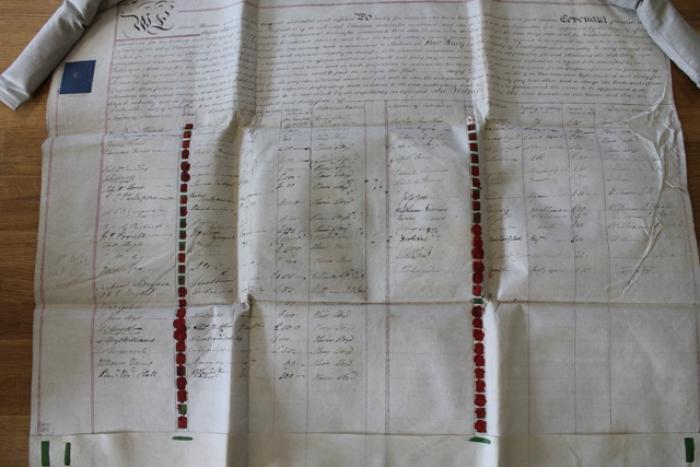
Covenant of Agreement of Subscribers: DB/96/2/2
In October 1834 a 'Covenant of Agreement' between the Subscribers was drawn up in order to apply for an Act of Parliament in relation to the construction of the new Harbour at New Quay (DB/96/2/2). Those, whose names and seals appear in the document, 'Do hereby... Covenant, promise and Agree with each other as Proprietors of the intended Harbour... and also to and with the Committee to be appointed by the Majority of the Subscribers for conducting and managing the application to Parliament... And also to and with the committee for the time being, who shall be constituted or appointed by virtue of the Act of Parliament, if the same shall be passed, to subscribe advance and lend the several sums of money placed by us respectively...for the purpose of obtaining an Act of Parliament for constructing and maintaining a Harbour at New Quay in the County of Cardigan and generally to carry the said Act of Parliament...'
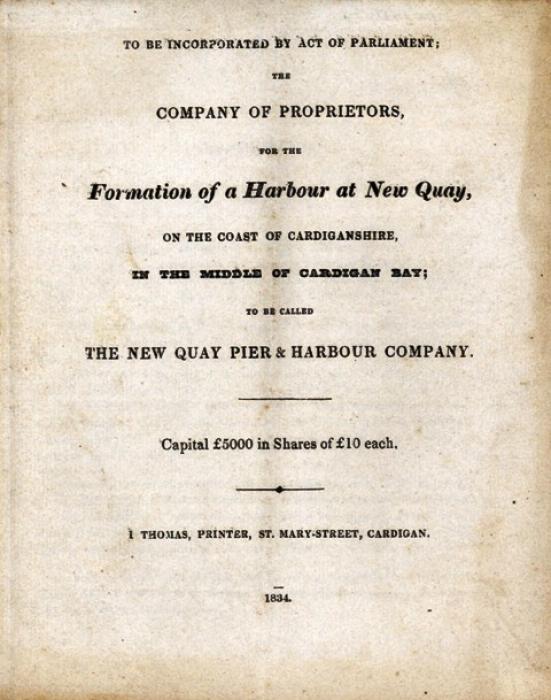
Prospectus for the New Quay Pier & Harbour Company: DB/96/2/3
In the same year a Prospectus was published advertising shares for sale in the new Company. £5000 in capital was needed; this amount to be raised through shares of £10 each. A return of 7% was forecast (DB/96/2/3), and it was noted that as soon as 400 shares were sold a meeting of the shareholders would be held at which a 'Provisional Committee' would be formed (DB/96/2/3). Tolls of 6d per ton on 'Foreign Vessels', 4d per ton on vessels seeking shelter from the weather but not unloading, and 2d per ton on all vessels belonging to 'His Majesty's subjects' who did not belong to the Port of New Quay, were proposed (DB/96/2/3).
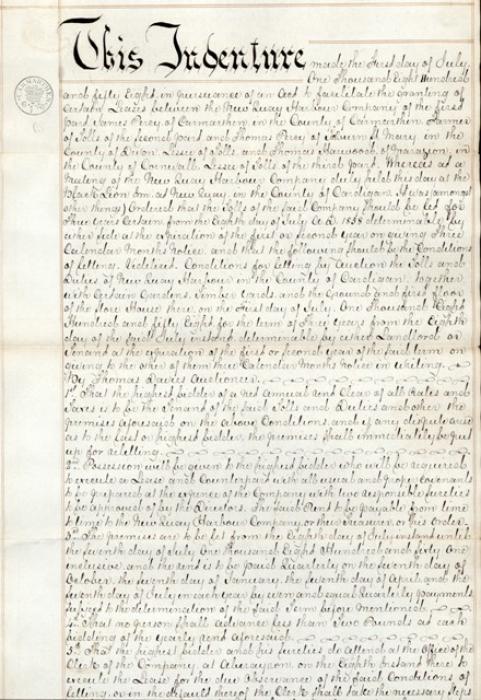
Lease relating to the Store House, and Harbour Tolls and Duties: DB/96/2/16
The collecting of Tolls and Duties, along with the lease of a Store-house (and gardens and timber yards), were let out by auction to the highest bidder (DB/96/2/12). Examples of these leases can be seen in the Indentures catalogued as DB/96/2/16-17, where the names of men from Carmarthen, Swansea, Essex, Devon, and Cornwall, as well as local men, are noted as being involved in such leases. In 1834 Daniel Beynon's plans for a new harbour were accepted; and the following year Rees William Jones, of Loughor in the County of Glamorgan, was appointed as Company Engineer (ibid: p.20). With the stone quarries at Pencastell Hill open, and the railroad to transport the stone for the pier in place, work on the new pier commenced in 1836 (ibid: p.20). The first tolls were collected in 1837.
As well as attending to its own affairs - business was flourishing during the 1840s - the New Quay Harbour Company was also involved with other initiatives within the town. George Bowen Jordan Jordan, one of the Director's of the New Quay Harbour Company, was also a founder member, and one of the Trustees, of the New Quay Mutual Ship Assurance Company, set up in 1857/8 (DB/96/2/13-14). The New Quay Harbour Company also leased land, from 1897 for a period of sixty years, at a rent of £1 1s per annum, to the 'Royal National Life-Boat Institution for the Preservation of Life from Shipwreck' for the construction of a Life-Boat House (DB/96/2/29).

Conveyance relating to land leased to the New Quay Patent Slip Company: DB/96/2/18
And, in 1863, the New Quay Harbour Company sold three roods and sixteen perches of land to The New Quay Patent Slip Company: a Joint Stock Company formed to raise the considerable capital needed for the construction of a Patent Slip (DB/96/2/18) - a large steel cradle which runs up and down an inclined permanent slipway on wheels and rails, making it easier to lift ships from the water for repair (Passmore,1992: p.72-3).
Initial success led to gradual decline in the 1880s, however, as income from tolls began falling, the payment of dividends diminished, and the cost of dredging the harbour of silt took its toll (Passmore, 1992: p.104). An average yearly dividend of 8s on each £10 share during the period 1851-1859 had fallen, decade by decade, to an average of 3s 6d per £10 share during the 1890s (DB/96/2/28). By 1882 the Pier itself was suffering from structural damage/ collapse. Messrs Evan Davies and John Davies, Masons, were employed to 'repair the inner wall of the Company Pier at New Quay', where the 'bulge or breach in the said Pier begins and terminating at the extreme end thereof, in a lateral direction being Forty two feet in length over wall' (DB/96/2/20).

Contract for repairing the pier: DB/96/2/20
The late 19th century and early 20th century appears to have been a litigious one for the New Quay Harbour Company. They were embroiled in legal cases with the Aberayron [Aberaeron] Steamship Company over the refusal of the latter to pay any harbour dues for the preceding year; the Steamship Company countered that the Harbour was in such a dire state (badly silted up) that no dues should legitimately be claimed, and further argued over the exact limits of the Harbour. Counsel Opinion ruled in favour of the Harbour Company â whilst their formative Act of Parliament empowered them to construct a Harbour it did not specifically state their obligation to maintain it â but urged the Harbour Company to put up notices setting out the charges payable (DB/96/2/32). A subsequent Case was brought by the New Quay Harbour Company, claiming that a 'proper list of tolls' was clearly displayed but had rotted away. In the same Case document Opinion was sought from Counsel regarding the matter of unclaimed dividends â many original shareholders had passed away, or moved and a considerable deficit of unpaid dividends had accumulated: could the Company use these funds, they wondered, to remedy the defects in the Harbour which the Steamship Company complained of (DB/96/2/33). The Company was told that: a) a new Toll boards must be put up, or they risked legal action against them if they refused; and b) dividends which had been unclaimed, and whose shareholders were untraceable, for greater than 6 years may be used by the Company to further their business (DB/96/2/33).

Case for the Opinion of Counsel: between New Quay Harbour Company and Aberayron Steamship Company: DB/96/2/33
But contention did not end there. In 1899 a Petition was submitted to the Board of Trade from 'tradesmen, merchants, and ship-owners resident in New Quay', concerned with the 'adverse affect on the depth of water subsequent to the constructing of the harbour, which is now silted up' (DB/96/2/38). They implored the Board of Trade to exercise their 'power and authority' so as to secure to the trades-people, ship-owners, and the general public of New Quay and its district, 'their just rights, in respect to accommodation of ships and protection to trade, in the Harbour of New Quay' (DB/96/2/38). They cited the plight of the S.S. Norseman, owned by the Aberayron [Aberaeron] Steam Packet Company, which was unable to access the harbour due to the shallowness of water there and was thus forced to discharge its wares onto the foreshore instead. Small vessels were also affected, being obliged to lie in the harbour for periods from 5-14 days at a time waiting for a high enough tide to discharge their goods. The petitioners also blamed the failure of the Great Western Railway to extend their line to New Quay on the 'un-navigable state of the harbour'. And improvements to the harbour would encourage many more fishermen to land their catches there, thus furthering local fortunes all round (DB/96/2/38).
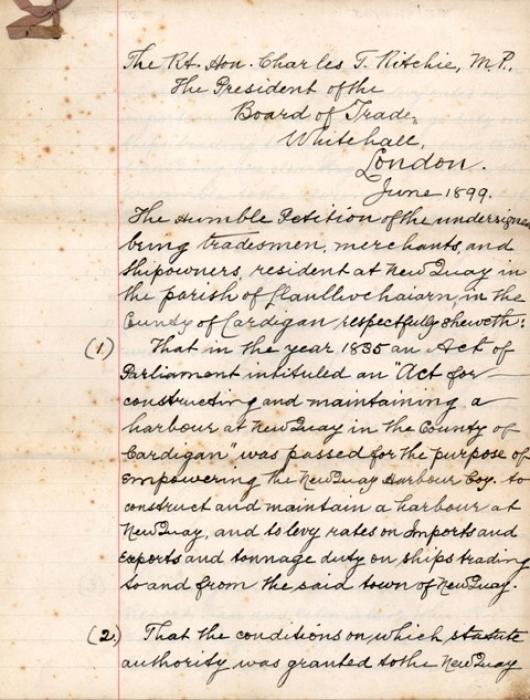
Petition to the Board of Trade from New Quay Residents concerning the New Quay Harbour Company: DB/96/2/38
On 10th March 1899 a 'strong deputation appointed by an enthusiastic public meeting' questioned the Director's of the Company on the subject of the development of the Vrondolay Quarry. It was considered by the petitioners that the terms suggested by the Company were 'utterly unjust and impracticable', viz: either the owner of the quarry works should under the present conditions or construct the New Pier at his own expense, for which the Company would levy dues and tonnage duties (DB/96/2/38). They also contended that the new harbour afforded no 'better accommodation for ships, or protection to trade' than the original natural one did. As part of their support for this claim they mentioned the wrecking of the 'Bronwen', the 'Beatrice', and the 'J. C. W.' in the mouth of, or close to, the harbour. They also alleged that the harbour offered no support to their 'small sailing boats', and noted the injurious effect of the harbour on the herring fishermen. On account of 'un-navigable state of the harbour and the consequent damage to trade', the Aberayron [Aberaeron] Steam Packet Company and a 'number of local trades-people and merchants absolutely refuse payment of Harbour Dues to the New Quay Harbour Company; and they are 'heartily supported' in their action against this 'manifold injustice' by the 'whole towns and districts of New Quay and Aberayron' (DB/96/2/38). The response from the Board of Trade is not reflected in the documents which form this collection. But whatever the official outcome, in 1901 the New Quay Harbour Company set out plans to improve the harbour by constructing an extension to the existing Slipway and removing rocks and stones from the seaward end of the Pier (DB/96/2/42).
In 1903 the Company sought legal opinion as to their status as a Company, as the 'majority of the shareholders' now wished to re-constitute the Company as a Limited Company and thus limit their potential liability as individual shareholders. In addition, many of the original shareholders were now untraceable, for one reason or another (DB/96/2/44). It seems likely that the Company was experiencing considerable financial difficulties.
Six years later, in 1909, the Company was involved in another legal case (DB/96/2/45). Captain Richard Price Jordan D.S.O took issue with the Company's policy of not honouring dividends payable on claims older than six years â mainly because several years worth were due to him under the Last Will and Testament of his grandfather, George Bowen Jordan Jordan â and their insistence on the receipt of a notice of 'Indemnity' from him before they would issue a duplicate certificate in his name. The eventual outcome of the dispute is not recorded.
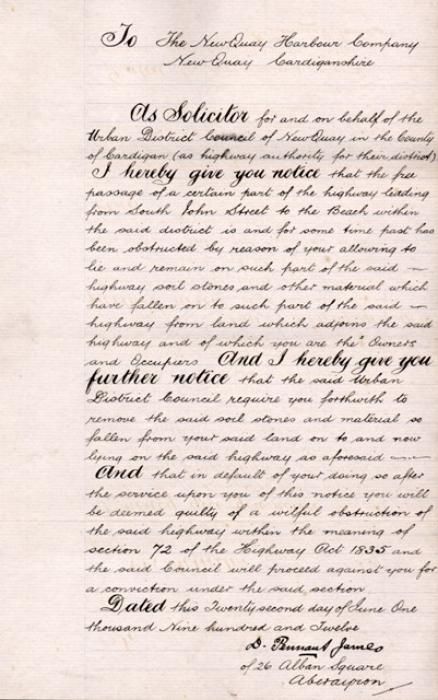
Case for the Opinion of Counsel: between New Quay Harbour Company and New Quay Urban District Council: DB/96/2/48
After a period of another six years, the Company was again involved in litigation. In March 1912, the New Quay Harbour Company was in dispute with New Quay Urban District Council (DB/96/2/48) over the clearing of an obstruction, caused by a landslip, which was blocking the road to the beach in New Quay. The road ran alongside land which the Harbour Company leased to the Urban District Council. Opinion found against the Harbour Company and they were ordered to remove the offending blockage and bear the cost of its removal (DB/96/2/48).
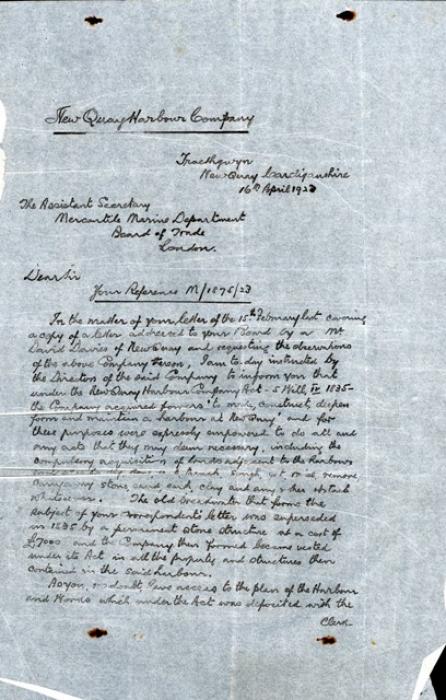
Letter to The Assistant Secretary, Mercantile Marine Department, Board of Trade, London, from the Chairman of the New Quay Harbour Company: DB/96/2/54
Further contention arose over the matter of the old New Quay Breakwater (DB/96/2/54-55). The Company, as part of its 'necessary repairs' to the main Pier of the Harbour deemed it necessary to remove the old breakwater (which, it was alleged, was the 'principal cause' of the Harbour silting up so badly), unaware that David Davies of New Quay intended to re-erect the old breakwater. Captain David Davies and a group of twelve fishermen (see DB/96/2/55) then appealed to the Board of Trade to intervene on their behalf. Again, unfortunately, the outcome is not recorded in the documents.
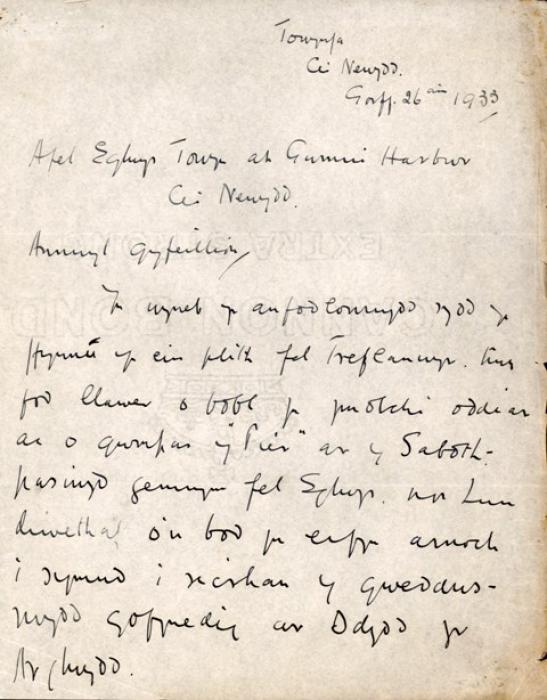
Letter relating to Sunday Bathing at New Quay Harbour: DB/96/2/61
A rather more morally (than legally) implicated matter arose in 1933 when the Reverend T. Orchwy Bowen of Townyfa Chapel, and Pastor J. Timothy Davies of the Tabernacle Church, on behalf of their congregations, appealed to the Company to disallow the practice of bathing from its Pier on a Sunday, so that . Whilst the Directors' of the Harbour Company were 'in sympathy' with the 'object of the petitions' they felt that the Church and/ or Chapel should bear the cost of producing a prohibitive notice, which the company would then happily display on their premises. Whether the 'splendid tradition of the past' in which 'untarnished... quiet, restful, Sabbath day as a priceless inheritance' (DB/96/2/62) was preserved as requested by Pastor Davies is not known.
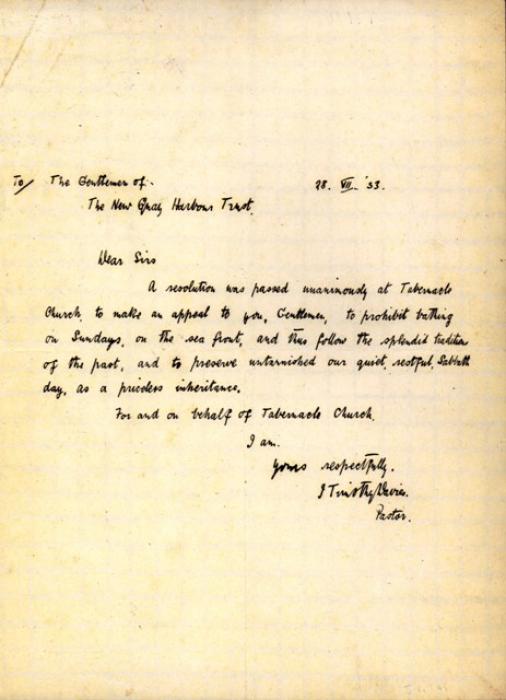
Letter relating to Sunday Bathing at New Quay Harbour: DB/96/2/62
By the late 1930s the end of the New Quay Harbour Company was in sight. Major Williams noted that the Local Council had applied for a 'Provisional Order' in 1937, but that the petition had been 'roaming from one Ministry to another ever since' (DB/96/2/70). Documents held at The National Archives (TNA) record how, from 1943, repairs were being made to the Harbour prior to its sale to the Urban District Council (TNA: MAF/209/471); and in 1948 an application was made to the British Transport Commission by the Council for take-over of the Company (TNA: AN/13/1260).
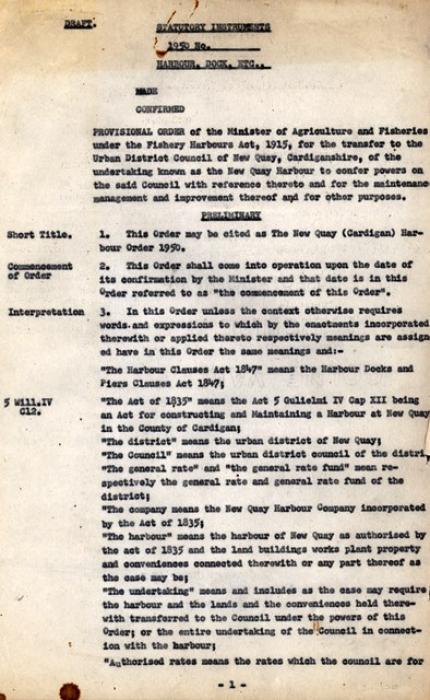
Statutory Instruments relating to the transfer of New Quay Harbour to New Quay Urban District Council: DB/96/2/71
The finale occurred in 1950 when 'Statutory Instruments relating to the transfer of New Quay Harbour to New Quay Urban District Council' were filed (DB/96/2/71). After over a hundred years of existence, the days of the New Quay Harbour Company were finally over.
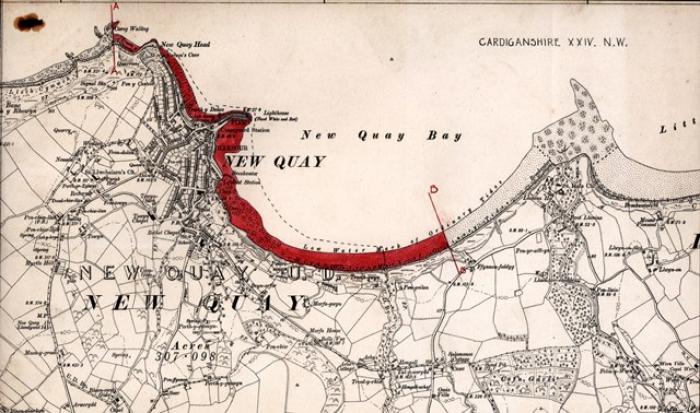
Plan showing the extent of land leased by the Company for clay and mineral extraction, 1927: DB/96/2/58
The full catalogue can be viewed at Ceredigion Archives: New Quay Harbour Company
References
Primary
Ceredigion Archives: New Quay Harbour Company Collection: DB/96
The National Archives (TNA): British Transport Commission and the British Railways Board: AN/13/1260: New Quay Harbour: Application from New Quay Urban District Council to Take Over the Harbour, 1948
The National Archives (TNA): Ministry of Agriculture and Fisheries and Ministry of Agriculture, Fisheries and Food: MAF/209/471: New Quay Harbour, Cards: Restoration of Harbour and Sale to Urban District Council, 1943-1949
Secondary
Passmore, S. C., Farmers & Figureheads: The Port of New Quay and its Hinterland (Dyfed County Council, Aberystwyth: 1992)
Datblygwyd y wefan gan Technoleg Taliesin





